The AMD Ryzen Threadripper 3960X and 3970X Review: 24 and 32 Cores on 7nm
by Dr. Ian Cutress, Andrei Frumusanu & Gavin Bonshor on November 25, 2019 9:05 AM ESTPower Consumption
One of our key conclusions from our Ryzen 9 3950X review is that AMD’s TDP number on the box was now somewhat a blurred line, with the processor instead taking the ‘Package Power Tracking’ or PPT value as its true peak power consumption. This meant that for a processor to have 105 W TDP on the box, the default PPT of 142 W meant that we saw power consumption around 142 W rather than 105 W. One concern going into this review is that AMD would take a similar line with the Zen 2-based Threadripper parts as well.
Both of the TR 3960X and TR 3970X processors have a list box TDP of 280 W, which is a new ‘record’ for high power consumption in a consumer CPU. In the enterprise space we see some specialist processors break the 400W mark, but those CPUs exist in environments with a variety of cooling methods and sound isn’t much of a concern. Conversely, these AMD processors will have to live in a box under someone’s desk, so there has to be a point where the TDP is too much. Last AMD generation was 250W, this one is 280W: if we’re not there already, then this should be a practical limit. AMD of course recommends liquid cooling with a good pump and a big radiator, so anyone buying one of these processors should look into spending at least another $120+ on a good liquid cooling system.
For our power consumption metrics, we performed our usual testing: using an affinity mask to limit the cores in use, implement a high-powered workload, and then measure the power readings 30 seconds in. We take the power readings from the processor itself, using the internal registers that are designed to regulate how much the processor does a form of turbo but also regulate temperatures and so forth. This method is broadly accurate, assuming the motherboard supports the external reporting of these values, but depending on the processor family it also gives us insights into how much power is being derived from the cores individually and the package as a whole.
Here’s what we get for the 24-core 3960X:
When a single core is active, it consumes ~13.5 watts. This slowly goes down when more cores get loaded, but at 6 cores loaded we are still consuming ~12 watts per core. Even at 16 cores loaded, we’re still around 10 watts per core. This is pretty impressive. At full core loading, we’re fluctuating between 6 and 11 watts per core, as workloads get moved around to manage core loading.
From the peak power perspective, we hit 280 W with 22 cores loaded. It drops off a bit after that, like we saw with the Ryzen 9 3950X, but not by much at this time. It should be noted that as we reach these higher values, out of those 280 W, around 205 W is being used by the cores, while 75 W or so is for everything else: that means memory controllers, PCIe root complexes, and the infinity fabric. This 75 W value doesn’t vary that much, starting at 68 W even at single core load. This indicates that either IF doesn’t take much power as more cores are used, or it is on all the time.
Moving to the 3970X, and we see a similar picture:
With more cores, the power is spread around a lot more. One core loaded tops out at 13 watts, and at 11 cores loaded we can still manage above 10 watts per core. When fully loaded, we move down to as low as 3 W per core, but it does average out to around 6 watts per core. Checking the frequency at this loading and despite the 3.7 GHz base frequency, we actually have all the cores at 4.0 GHz. 32 cores at 4.0 GHz? Yes please.
The peak power metrics rise to just over 280 W when we hit 23 cores loaded and stay there, with no dip after hitting the peak. It would seem that the 3970X appears better built in that regard.
If we comment on the power between the cores and everything else, we again get a 205-210 W value for the power in the cores. This leaves 75 W or so for the rest of the chip, almost identical to the 3960X, and again this doesn’t waver much from 1 core loaded to all-cores loaded.
What will be interesting to see will be when we get the 3990X in to test as comparison. I expect that 75W value to go up – even if it goes to 100W, that leaves 180W for 64 cores, or around 3 W per core. Based on my estimates, we could be looking at anywhere from 3.0-3.5 GHz per core, which actually fits in nicely with the frequencies of the EPYC 7H12 which is also a 64-core 280W part, but for the high performance compute market.
When comparing peak power consumption to all the other CPUs in our review, as expected our new CPUs are near the top of the charts.
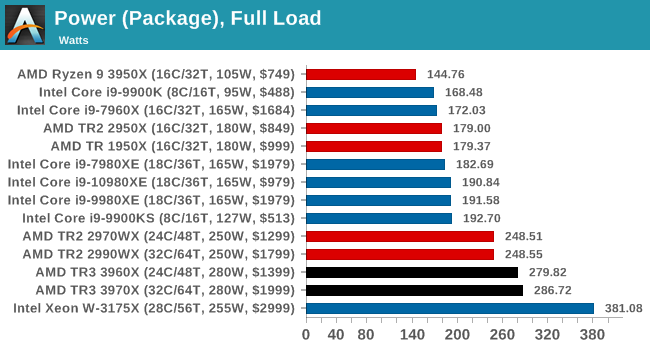
Only the unlocked 28-core from Intel peaks at a higher power, but funnily enough, that should only have a 255W TDP. So for four more cores, AMD’s peak power is still 100W below Intel’s. That’s the ‘power’ of the 7nm process node and some good quality chiplets.


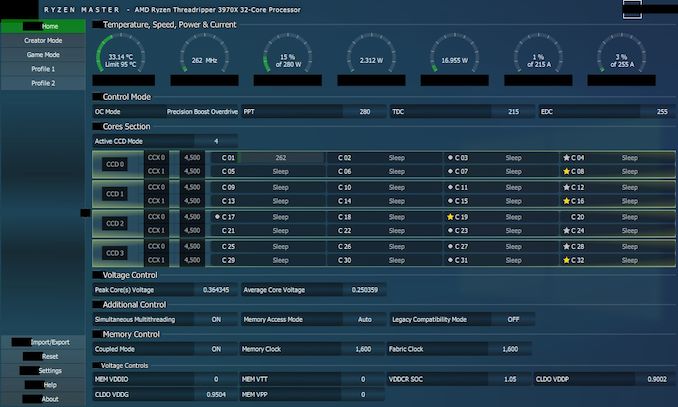
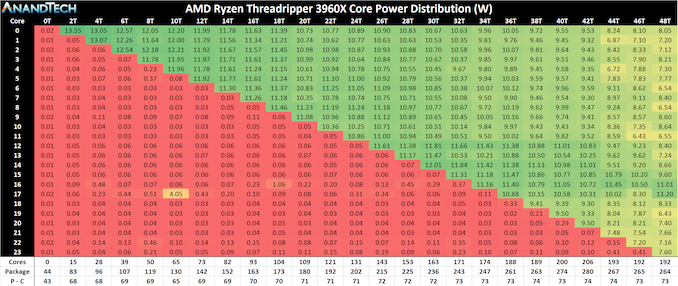
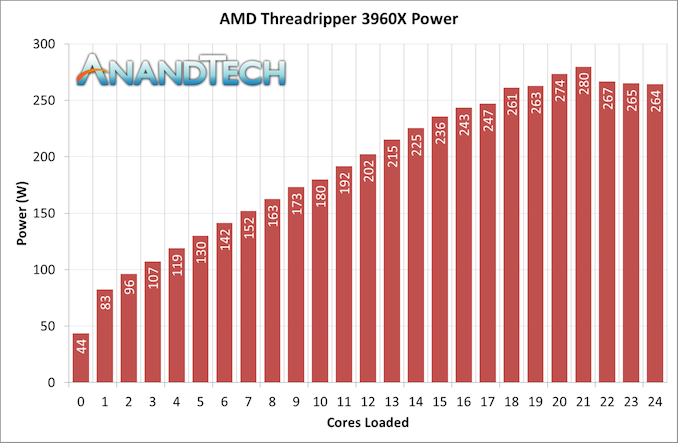
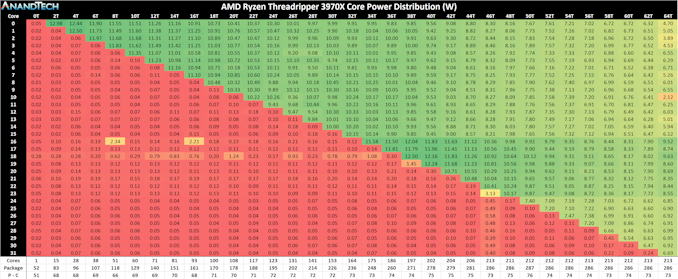
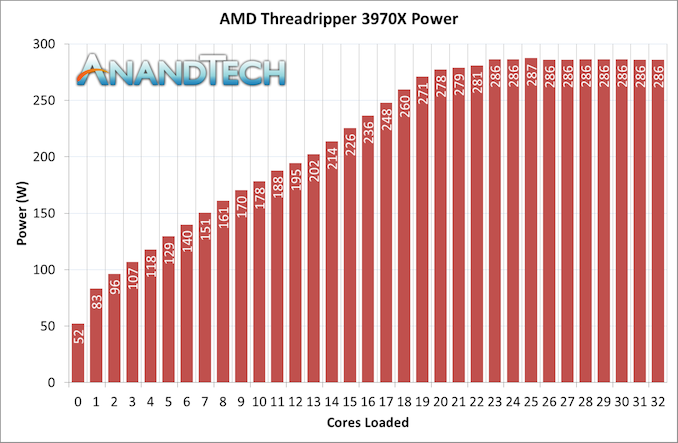








245 Comments
View All Comments
Fulljack - Wednesday, November 27, 2019 - link
well, even 64eu gen11 graphics actually couldn't even surpass vega 10 on 3700u.YazX_ - Monday, November 25, 2019 - link
@melgross, LOL cool story, your butthurt is so obvious, being a fanboy is something but living in denial is something else.the only reason one would post such comment is to be an Intel employee, heck, even Intel employees are admitting their defeat.
JKflipflop98 - Wednesday, November 27, 2019 - link
No, we're not.mickrussom - Tuesday, December 3, 2019 - link
If you really are an Intel employee- shame!, shame!, shame! - especially if you had anything to do with:Spectre 1/2, Meltdown 3/3a, Speculative Store Bypass, Foreshadow, L1TF, Fallout/MSBDS, ZombieLoad/MFBDS, RIDL MLPDS/MDSUM
It is utterly criminal what Intel has done. I have zero respect for Intel and it is only by the grace of the US Government Intel is allowed to live. What is happening to Boeing should be happening to Intel for the criminally negligent brain damaged cheating lying trash-chips they have produced with these horrific faults for over a decade. This is far worse than FDIV. And I got a new CPU for FDIV. This is a crime wave and Intel has received a pardon and all of us are left with broken chips that when patch by the OS run half speed or worse.
So to all Intel employees, you better hold your heads down in utter shame until the next wave of CPUs comes out. And support ECC on all the chips - its criminally negligent to hold people hostage with RAM errors.
WaltC - Monday, November 25, 2019 - link
You don't really understand how the quarterly bookkeeping works, I can see. Intel's last quarter was already set in their ordering channels long before AMD's July launch of Epyc Zen 2, R3k, and TR3k is only now launching--it will be all of 2020 that you will see Intel's P&L's grow progressively leaner as you see AMD's grow progressively fatter. Generally it takes 2-3 quarters of progressively worse business before a company's woes begin to show up dramatically on the balance sheet, due to good will and other bookkeeping dodges. Next year will be a Halcyon year for AMD and a critical year for Intel no question about it. Already their roles have reversed, with Intel becoming the "value proposition"--but only provided Intel keeps on cutting its prices. What we've also seen predicted many times in the past is that AMD was *doomed*...;) Not..quite..;)Jimbo Jones - Monday, November 25, 2019 - link
@melgrose"Intel had its best year yet" ... more 10nm delays, so called "14nm shortages", no 10nm for desktop yet, nothing for server yet, same rehashed 14nm with the 10980XE bringing almost no improvement at all per core meanwhile in one generation Threadripper beings up to 32% improvement in multi, 20% in single thread, with no answer from Intel to any of these processors at all and their flagship 18 core HEDT being almost equal to Ryzen desktop in heavy workloads.
But that's ok, let's look ahead to 2020 ... Comet lake aims at add two cores and add 100mhz ... I guess that's pretty good ... for Intel ... ;-)
What IS impressive though, is Intel's ability to keep squeezing money out of gullible people willing to keep paying more money for less product -- I guess that's how they managed to make so much money last year?
mickrussom - Tuesday, December 3, 2019 - link
yeah, how quickly they forget Spectre 1/2, Meltdown 3/3a, Speculative Store Bypass, Foreshadow, L1TF, Fallout/MSBDS, ZombieLoad/MFBDS, RIDL MLPDS/MDSUM. they took our money and unlike Boeing they go no flak from FEDGOV for it. and then they act like arrogant rotten gordon gecko types while laughing to the bank while the CPUs still coming are patch against those flaws mostly in microcode and OS kernels STILL!maxxbot - Tuesday, November 26, 2019 - link
AMD didn't have these sorts of products in the past, trying to extrapolate past performance into the future is a fool's errand. Intel was the process champ for decades and guess what? It all changed overnightTargon - Tuesday, November 26, 2019 - link
Financials vs. products. Intel financials were up because many people were upgrading from older dual or quad core products, and OEMs are barely starting to offer third generation Ryzen based machines. For your typical consumer, not the gamers who can afford a $500 9900k, but your typical consumer, would you suggest Intel or AMD based products at this point? Intel has the 9600, 9700, and 9900 as good products, the rest are beaten by AMD products at the same price point.arcamdomain - Tuesday, December 17, 2019 - link
Nokia said the same thing about the phone market.